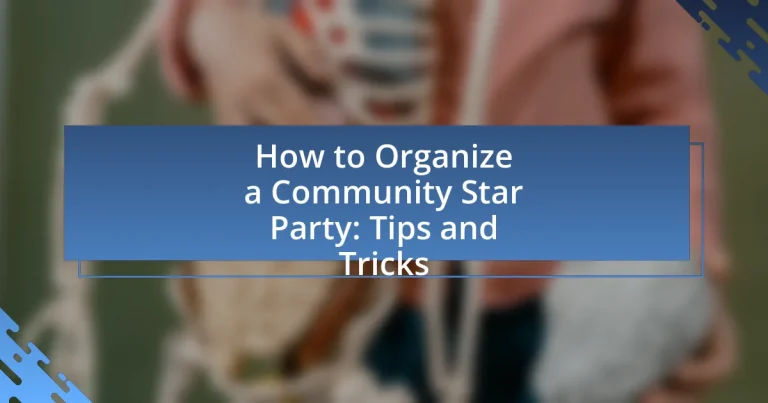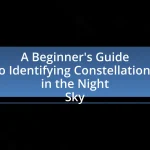A Community Star Party is an organized event that brings together community members to observe celestial objects and engage in educational activities related to astronomy. This article outlines the essential steps for planning a successful Community Star Party, including selecting an appropriate location, promoting the event, and ensuring adequate equipment and volunteer support. Key features such as hands-on experiences, educational presentations, and community engagement are emphasized, highlighting their importance in fostering interest in astronomy and enhancing social connections. Additionally, the article addresses common challenges faced during organization and offers best practices to create an inclusive and welcoming atmosphere for all attendees.

What is a Community Star Party?
A Community Star Party is an organized event where members of a community gather to observe and learn about celestial objects through telescopes and other astronomical tools. These gatherings often include educational presentations, guided stargazing sessions, and opportunities for participants to engage with local astronomers. Community Star Parties aim to foster interest in astronomy and promote community engagement in science-related activities.
How does a Community Star Party differ from other astronomy events?
A Community Star Party differs from other astronomy events primarily in its focus on local engagement and accessibility for the general public. Unlike specialized astronomy conferences or observatory events that may cater to experts or enthusiasts, Community Star Parties are designed to invite families and individuals from the community to participate in stargazing and educational activities. These events often feature hands-on experiences, such as telescope viewing and interactive demonstrations, aimed at fostering interest in astronomy among attendees of all ages. The emphasis on community involvement is supported by the fact that many Community Star Parties are organized by local astronomy clubs or educational institutions, making them more approachable and inclusive compared to other, more formal astronomy gatherings.
What are the key features of a Community Star Party?
A Community Star Party typically features telescopes for public viewing, educational presentations about astronomy, and opportunities for community engagement. Telescopes allow attendees to observe celestial objects, enhancing their understanding of the night sky. Educational presentations often include talks by local astronomers or astronomy clubs, providing insights into various astronomical phenomena. Community engagement is fostered through interactive activities, such as Q&A sessions and hands-on demonstrations, which encourage participation and learning among attendees. These features collectively create an enriching experience that promotes interest in astronomy within the community.
Why are Community Star Parties important for local communities?
Community Star Parties are important for local communities because they foster social interaction and promote interest in astronomy. These events bring together individuals of all ages, encouraging collaboration and community bonding through shared experiences. Research indicates that community engagement in science-related activities enhances public understanding of scientific concepts, as seen in studies conducted by the National Science Foundation, which highlight the positive impact of informal science education on community cohesion and knowledge retention.
What are the goals of organizing a Community Star Party?
The goals of organizing a Community Star Party include fostering community engagement, promoting interest in astronomy, and providing educational opportunities. By bringing people together under the night sky, organizers aim to create a shared experience that enhances social connections and encourages collaboration among participants. Additionally, these events serve to educate attendees about celestial phenomena, encouraging curiosity and scientific literacy. Research indicates that community events like star parties can significantly increase public interest in science and technology, as evidenced by studies showing higher participation rates in STEM activities following such gatherings.
How can a Community Star Party promote interest in astronomy?
A Community Star Party can promote interest in astronomy by providing hands-on experiences with telescopes and celestial observations. These events allow participants to engage directly with the night sky, fostering curiosity and excitement about astronomical phenomena. Research indicates that interactive learning experiences, such as those offered at star parties, significantly enhance knowledge retention and interest in science-related fields. For instance, a study published in the Journal of Astronomy & Earth Sciences Education found that public outreach events increase participants’ understanding of astronomical concepts and encourage further exploration of the subject.
What role does community engagement play in a successful event?
Community engagement is crucial for the success of an event as it fosters participation, builds relationships, and enhances the overall experience. Engaging the community ensures that the event meets the interests and needs of its attendees, leading to higher attendance and satisfaction. For instance, events that actively involve local residents in planning and execution often see increased turnout; a study by the National Endowment for the Arts found that community involvement can boost attendance by up to 30%. Additionally, engaged communities are more likely to promote the event through word-of-mouth, further amplifying its reach and impact.

How do you plan a Community Star Party?
To plan a Community Star Party, first, select a suitable location with minimal light pollution, such as a park or open field. This ensures optimal visibility of celestial objects. Next, choose a date and time, ideally on a weekend and during a new moon phase to enhance darkness. Promote the event through local community boards, social media, and schools to attract participants. Arrange for telescopes and knowledgeable volunteers to assist attendees in observing the night sky. Additionally, prepare educational materials about the stars and planets to enhance the experience. According to the American Astronomical Society, community star parties can significantly increase public interest in astronomy, making proper planning essential for success.
What are the essential steps in organizing a Community Star Party?
The essential steps in organizing a Community Star Party include selecting a suitable location, securing necessary permissions, promoting the event, arranging telescopes and equipment, and coordinating volunteers. Selecting a location involves finding a dark area with minimal light pollution, which is crucial for optimal stargazing. Securing permissions may require contacting local authorities or landowners to ensure the event can take place legally. Promoting the event through social media, local newspapers, and community boards helps attract participants. Arranging telescopes and equipment ensures that attendees have access to viewing tools, while coordinating volunteers is necessary for managing the event and assisting participants. These steps are validated by successful community events that emphasize planning and community engagement.
How do you choose the right location for the event?
To choose the right location for a community star party, assess factors such as accessibility, light pollution levels, and available facilities. Accessibility ensures participants can easily reach the site, while low light pollution enhances visibility of celestial objects, making the experience more enjoyable. Facilities like restrooms and parking are essential for comfort and convenience. Research indicates that locations with minimal artificial light, such as rural areas or designated dark sky parks, significantly improve stargazing experiences, as noted by the International Dark-Sky Association.
What factors should be considered when selecting a date and time?
When selecting a date and time for a community star party, consider astronomical events, weather conditions, and local schedules. Astronomical events, such as meteor showers or planetary alignments, can enhance the experience and attract more participants. Weather conditions, particularly cloud cover and moon phase, significantly impact visibility; clear skies and a new moon are ideal for stargazing. Additionally, local schedules, including holidays and community events, should be reviewed to avoid conflicts and maximize attendance. These factors collectively ensure a successful and enjoyable star party.
How can you effectively promote the Community Star Party?
To effectively promote the Community Star Party, utilize a multi-channel marketing approach that includes social media, local community boards, and partnerships with schools and astronomy clubs. Social media platforms like Facebook and Instagram can reach a broad audience quickly, allowing for event sharing and engagement. Posting on local community boards and websites ensures visibility among residents who may not be active on social media. Collaborating with schools and astronomy clubs can leverage their networks to attract families and enthusiasts, increasing attendance. According to a study by the Pew Research Center, 69% of adults use social media, making it a powerful tool for event promotion.
What marketing strategies work best for attracting attendees?
Effective marketing strategies for attracting attendees include leveraging social media platforms, utilizing email marketing campaigns, and collaborating with local organizations. Social media platforms like Facebook and Instagram allow for targeted advertising, reaching specific demographics interested in astronomy and community events. Email marketing campaigns can effectively engage previous attendees and interested individuals by providing updates and exclusive content, leading to higher attendance rates. Collaborating with local organizations, such as schools and astronomy clubs, can enhance visibility and credibility, as these groups often have established networks that can be tapped into for promotion. According to a study by HubSpot, events promoted through social media see a 30% increase in attendance compared to those that are not, highlighting the effectiveness of these strategies.
How can social media be utilized to spread the word?
Social media can be utilized to spread the word about a community star party by creating event pages, sharing engaging content, and leveraging local groups. Event pages on platforms like Facebook allow organizers to provide details, invite attendees, and track RSVPs, which can increase participation. Sharing visually appealing content, such as photos of previous events or infographics about stargazing, can capture attention and encourage shares. Additionally, posting in local community groups or forums can reach a targeted audience interested in astronomy, enhancing visibility and engagement. According to a study by Pew Research Center, 69% of adults in the U.S. use social media, making it a powerful tool for outreach.

What resources are needed for a successful Community Star Party?
A successful Community Star Party requires telescopes, binoculars, star charts, and knowledgeable volunteers. Telescopes and binoculars provide attendees with the means to observe celestial objects, while star charts help participants identify constellations and planets. Knowledgeable volunteers enhance the experience by offering guidance and sharing information about astronomy. These resources are essential for creating an engaging and educational environment, ensuring that participants can fully appreciate the night sky.
What equipment is essential for a Community Star Party?
Essential equipment for a Community Star Party includes telescopes, binoculars, star charts, and red flashlights. Telescopes allow participants to observe celestial objects in detail, while binoculars provide a more portable option for stargazing. Star charts help attendees identify constellations and planets, enhancing their experience. Red flashlights are crucial for preserving night vision, enabling participants to navigate without disrupting their ability to see the stars. These items collectively ensure a successful and engaging star-gazing event.
How do you select telescopes and other viewing equipment?
To select telescopes and other viewing equipment, prioritize the type of astronomical observations you intend to make, such as planetary, deep-sky, or lunar viewing. For instance, a refractor telescope is ideal for planetary observations due to its clarity, while a reflector telescope is better suited for deep-sky objects because of its larger aperture. Additionally, consider the equipment’s portability, ease of setup, and user-friendliness, especially for community events where multiple users may be involved. Research shows that telescopes with an aperture of at least 4 inches provide a good balance between performance and accessibility for beginners, making them suitable for community star parties.
What additional materials or supplies should be prepared?
To organize a community star party, additional materials and supplies that should be prepared include telescopes, star charts, binoculars, blankets, and refreshments. Telescopes enhance the viewing experience by allowing participants to observe celestial objects in detail. Star charts provide guidance on identifying constellations and planets, while binoculars serve as a portable alternative for casual stargazers. Blankets offer comfort for sitting on the ground, and refreshments keep attendees energized and engaged throughout the event. These supplies are essential for creating an enjoyable and educational atmosphere during the star party.
How can volunteers contribute to the success of the event?
Volunteers can significantly contribute to the success of the event by providing essential support in various roles such as setup, coordination, and engagement with attendees. Their involvement ensures that tasks are completed efficiently, which enhances the overall experience for participants. For instance, volunteers can assist in setting up telescopes, managing registration, and facilitating activities, which allows for a smoother operation of the event. Research indicates that events with active volunteer participation often report higher satisfaction rates among attendees, as volunteers help create a welcoming atmosphere and foster community interaction.
What roles can volunteers take on during the Community Star Party?
Volunteers at the Community Star Party can take on various roles, including event setup, guiding attendees, operating telescopes, and providing educational information about celestial objects. Each role is essential for ensuring a smooth and engaging experience for participants. For instance, volunteers involved in event setup are responsible for arranging equipment and creating a welcoming environment, while those guiding attendees help manage crowd flow and enhance visitor engagement. Operating telescopes requires volunteers to have some knowledge of astronomy, allowing them to assist attendees in viewing celestial objects. Providing educational information enriches the experience by sharing insights about the night sky, making the event both enjoyable and informative.
How do you recruit and train volunteers effectively?
To recruit and train volunteers effectively, organizations should implement a structured approach that includes clear role definitions, targeted outreach, and comprehensive training programs. First, defining specific roles helps potential volunteers understand their responsibilities and the impact they can make, which increases engagement. Targeted outreach through social media, community events, and local organizations can attract individuals who are passionate about astronomy and community service.
Once volunteers are recruited, effective training should include orientation sessions that cover the event’s objectives, safety protocols, and hands-on practice with equipment. Research indicates that structured training increases volunteer retention rates by up to 50%, as it fosters confidence and competence among volunteers. Providing ongoing support and feedback during the event further enhances their experience and effectiveness.
What are some common challenges faced when organizing a Community Star Party?
Common challenges faced when organizing a Community Star Party include securing a suitable location, managing weather conditions, and ensuring adequate equipment availability. Securing a location often involves obtaining permits and ensuring accessibility for participants, which can be time-consuming. Weather conditions can be unpredictable, affecting visibility and attendance; for instance, cloudy skies can lead to cancellations. Additionally, ensuring that telescopes and other equipment are available and functioning properly is crucial, as technical issues can hinder the event’s success. These challenges require careful planning and contingency strategies to mitigate their impact.
How can weather conditions impact the event?
Weather conditions can significantly impact the success of a community star party by affecting visibility and participant comfort. Clear skies are essential for stargazing, as clouds can obstruct celestial views, leading to disappointment among attendees. Additionally, adverse weather such as rain or strong winds can force cancellations or limit outdoor activities, reducing overall participation. Historical data shows that events held during favorable weather conditions see up to 50% higher attendance compared to those held during inclement weather. Therefore, organizers must monitor forecasts and consider alternative dates to ensure optimal conditions for viewing.
What strategies can be implemented to handle unexpected issues?
To handle unexpected issues during a community star party, implement proactive planning, effective communication, and flexible problem-solving strategies. Proactive planning involves anticipating potential challenges, such as weather changes or equipment failures, and preparing contingency plans, like having backup telescopes or alternative indoor activities. Effective communication ensures that all team members and participants are informed about the event’s status and any changes, which can be facilitated through group messaging apps or announcements. Flexible problem-solving allows organizers to quickly adapt to unforeseen circumstances, such as relocating to a different site if the original location becomes unsuitable. These strategies are supported by successful event management practices, which emphasize the importance of preparation and adaptability in overcoming challenges.
What are the best practices for hosting a Community Star Party?
The best practices for hosting a Community Star Party include selecting a suitable location, promoting the event effectively, and ensuring adequate equipment and safety measures. A suitable location should be away from city lights to enhance visibility of celestial objects, as light pollution significantly impacts stargazing quality. Effective promotion can involve social media, local community boards, and schools to attract a diverse audience, which is essential for community engagement. Providing telescopes and binoculars, along with knowledgeable volunteers to assist attendees, enhances the experience and encourages learning about astronomy. Safety measures, such as ensuring a safe environment for participants and providing clear guidelines for equipment use, are crucial for a successful event. These practices are supported by successful community events that report increased attendance and participant satisfaction when these elements are prioritized.
How can you ensure a welcoming atmosphere for all attendees?
To ensure a welcoming atmosphere for all attendees, organizers should prioritize inclusivity and accessibility. This can be achieved by providing clear communication about the event details, ensuring the venue is accessible to individuals with disabilities, and creating a friendly environment through trained volunteers who can assist attendees. Research indicates that events with diverse representation and inclusive practices lead to higher satisfaction rates among participants, as shown in studies by the Event Marketing Institute, which found that 78% of attendees feel more welcomed when diversity is prioritized.
What tips can enhance the overall experience for participants?
To enhance the overall experience for participants at a community star party, organizers should ensure clear communication about the event details, including location, time, and activities. Providing a well-structured schedule allows participants to plan their attendance and engage fully. Additionally, offering educational materials or guided sessions led by knowledgeable astronomers can deepen participants’ understanding and enjoyment of the night sky. Research indicates that interactive experiences, such as hands-on activities or Q&A sessions, significantly increase participant satisfaction and engagement. For instance, a study by the American Astronomical Society found that events with interactive elements saw a 40% increase in positive feedback from attendees.


